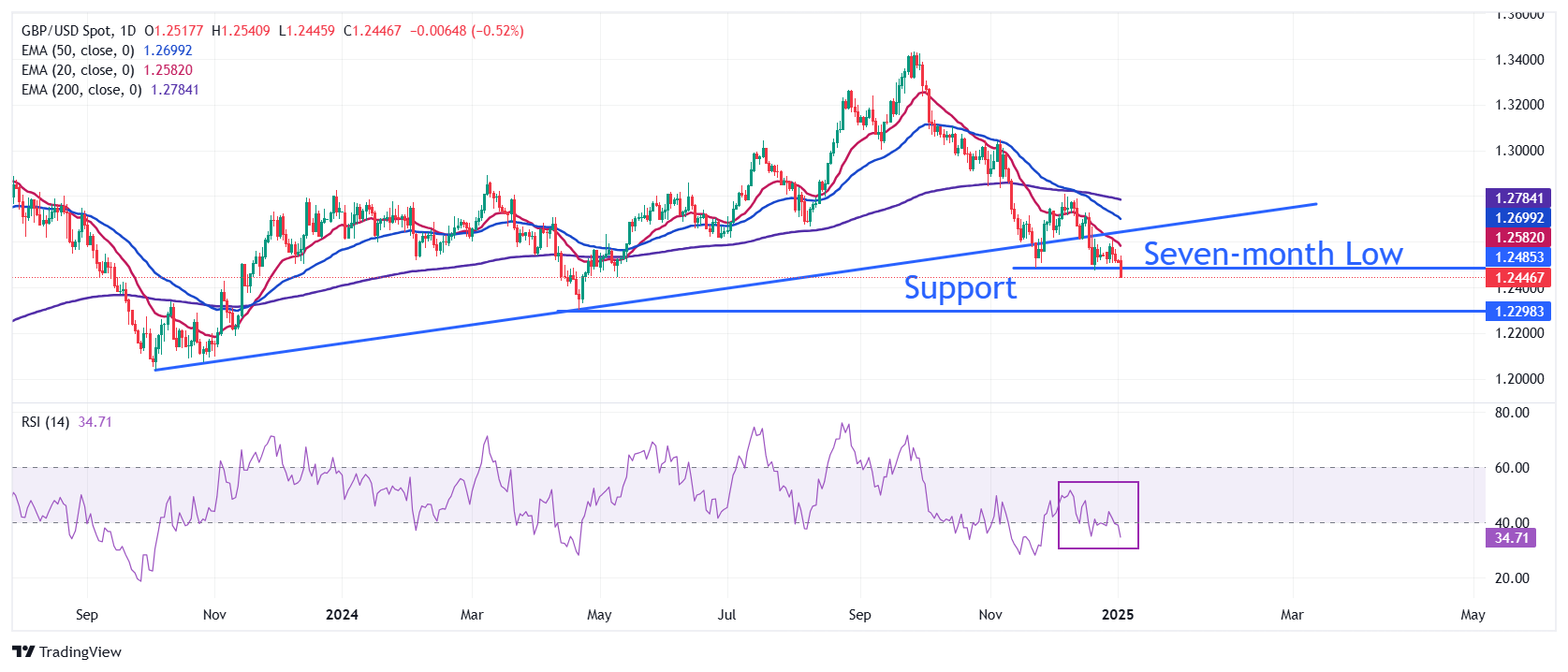Pound Sterling tumbles against US Dollar on Fed’s cautious rate-cut approach

- The Pound Sterling plummets against the US Dollar as the Fed is expected to reduce interest rates less than previously anticipated this year.
- The British currency trades weakly across the board as analysts at Goldman Sachs expect the BoE to deliver four interest rate cuts this year.
- Investors await an array of US labor market data on Thursday for fresh Fed policy guidance.
The Pound Sterling (GBP) tumbles to near 1.2440 against the US Dollar (USD) at the start of the year, the lowest level seen in more than eight months. The GBP/USD pair faces an intense sell-off as the US Dollar Index (DXY) refreshes a more-than-two-year high at around 108.60.
The greenback strengthens as investors expect incoming policies from President-elect Donald Trump to boost economic growth and inflationary pressures in the United States (US). This scenario will compel the Federal Reserve (Fed) to slow the pace of rate cuts, which will be favorable for the US Dollar and US Treasury yields.
Meanwhile, Fed officials have already recommended fewer interest rate cuts this year. However, Fed Chair Jerome Powell refrains from predicting the likely impact of Trump’s policies, such as immigration controls, higher import tariffs, and lower taxes, on the economy.
The latest dot plot at the Fed’s Summary of Economic Projections showed that policymakers collectively see Federal Fund rates heading to 3.9% by the end of 2025, higher than the 3.4% forecasted in September.
Going forward, investors will pay close attention to a slew of US labor market-related economic indicators, which will be released next week. Signs of improving labor demand would further weigh on Fed rate cut prospects, while weak numbers would boost them.
But before that, investors will focus on the ISM Manufacturing Purchasing Managers Index (PMI) data for December, which is scheduled for Friday. The Manufacturing PMI is expected to come in at 48.3, slightly lower than the 48.4 in November.
Daily digest market movers: Pound Sterling weakens on BoE dovish bets
- The Pound Sterling weakens against its major peers on Thursday amid growing expectations that the Bank of England (BoE) will follow a less gradual rate-cut approach this year.
- The BoE reduced its key borrowing rates by 50 basis points (bps) to 4.75% in 2024. BoE’s policy-easing pace was slow compared to its European and North American peers as inflation in the United Kingdom (UK) service sector remained highly stubborn due to sticky wage growth.
- However, a slightly faster rate-cut pace is expected this year, as a slowdown in labor demand would tame price pressures. In a note this week, analysts at Goldman Sachs said that the BoE will cut interest rates each quarter through the year. This indicates that the BoE policy rate will decline to 3.75% by the year-end.
- On the economic front, the final estimate for S&P Global/CIPS Manufacturing PMI has come in weaker than preliminary reading. The Manufacturing PMI contracted to 47.0, faster than flash reading of 47.3.
Technical Analysis: Pound Sterling breaks below 1.2500
The Pound Sterling breaks below the psychological support of 1.2500 against the US Dollar on Thursday. The outlook of the GBP/USD pair was already vulnerable as it trades below the upward-sloping trendline around 1.2600, which is plotted from the October 2023 low of 1.2035.
All short-to-long-term Exponential Moving Averages (EMAs) are sloping down, suggesting a strong bearish trend in the long run.
The 14-day Relative Strength Index (RSI) oscillates below 40.00, signaling that strong downside momentum.
Looking down, if the pair breaks below the immediate support of 1.2485, it is expected to find a cushion near the April 22 low at around 1.2300. On the upside, the December 17 high at 1.2730 will act as key resistance.
Economic Indicator
S&P Global/CIPS Manufacturing PMI
The Manufacturing Purchasing Managers Index (PMI), released on a monthly basis by both the Chartered Institute of Procurement & Supply and S&P Global, is a leading indicator gauging business activity in the UK’s manufacturing sector. The data is derived from surveys of senior executives at private-sector companies. Survey responses reflect the change, if any, in the current month compared to the previous month and can anticipate changing trends in official data series such as Gross Domestic Product (GDP), industrial production, employment and inflation. The index varies between 0 and 100, with levels of 50.0 signaling no change over the previous month. A reading above 50 indicates that the manufacturing economy is generally expanding, a bullish sign for the Pound Sterling (GBP). Meanwhile, a reading below 50 signals that activity among goods producers is generally declining, which is seen as bearish for GBP.
Last release: Thu Jan 02, 2025 09:30
Frequency: Monthly
Actual: 47
Consensus: 47.3
Previous: 47.3
Source: S&P Global
